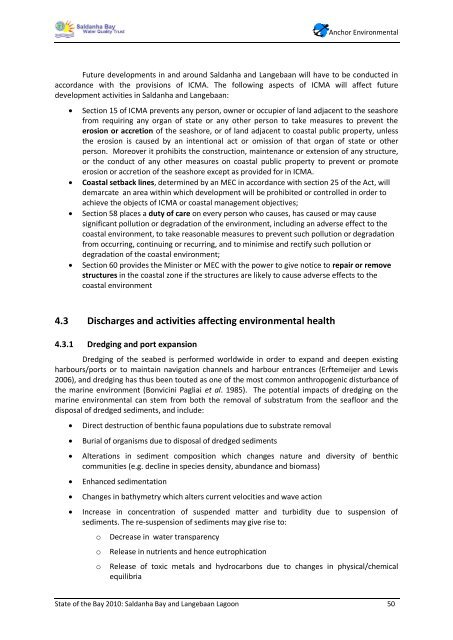State of the Bay Report 2010-Final - Anchor Environmental
State of the Bay Report 2010-Final - Anchor Environmental
State of the Bay Report 2010-Final - Anchor Environmental
You also want an ePaper? Increase the reach of your titles
YUMPU automatically turns print PDFs into web optimized ePapers that Google loves.
<strong>Anchor</strong> <strong>Environmental</strong><br />
Future developments in and around Saldanha and Langebaan will have to be conducted in<br />
accordance with <strong>the</strong> provisions <strong>of</strong> ICMA. The following aspects <strong>of</strong> ICMA will affect future<br />
development activities in Saldanha and Langebaan:<br />
Section 15 <strong>of</strong> ICMA prevents any person, owner or occupier <strong>of</strong> land adjacent to <strong>the</strong> seashore<br />
from requiring any organ <strong>of</strong> state or any o<strong>the</strong>r person to take measures to prevent <strong>the</strong><br />
erosion or accretion <strong>of</strong> <strong>the</strong> seashore, or <strong>of</strong> land adjacent to coastal public property, unless<br />
<strong>the</strong> erosion is caused by an intentional act or omission <strong>of</strong> that organ <strong>of</strong> state or o<strong>the</strong>r<br />
person. Moreover it prohibits <strong>the</strong> construction, maintenance or extension <strong>of</strong> any structure,<br />
or <strong>the</strong> conduct <strong>of</strong> any o<strong>the</strong>r measures on coastal public property to prevent or promote<br />
erosion or accretion <strong>of</strong> <strong>the</strong> seashore except as provided for in ICMA.<br />
Coastal setback lines, determined by an MEC in accordance with section 25 <strong>of</strong> <strong>the</strong> Act, will<br />
demarcate an area within which development will be prohibited or controlled in order to<br />
achieve <strong>the</strong> objects <strong>of</strong> ICMA or coastal management objectives;<br />
Section 58 places a duty <strong>of</strong> care on every person who causes, has caused or may cause<br />
significant pollution or degradation <strong>of</strong> <strong>the</strong> environment, including an adverse effect to <strong>the</strong><br />
coastal environment, to take reasonable measures to prevent such pollution or degradation<br />
from occurring, continuing or recurring, and to minimise and rectify such pollution or<br />
degradation <strong>of</strong> <strong>the</strong> coastal environment;<br />
Section 60 provides <strong>the</strong> Minister or MEC with <strong>the</strong> power to give notice to repair or remove<br />
structures in <strong>the</strong> coastal zone if <strong>the</strong> structures are likely to cause adverse effects to <strong>the</strong><br />
coastal environment<br />
4.3 Discharges and activities affecting environmental health<br />
4.3.1 Dredging and port expansion<br />
Dredging <strong>of</strong> <strong>the</strong> seabed is performed worldwide in order to expand and deepen existing<br />
harbours/ports or to maintain navigation channels and harbour entrances (Erftemeijer and Lewis<br />
2006), and dredging has thus been touted as one <strong>of</strong> <strong>the</strong> most common anthropogenic disturbance <strong>of</strong><br />
<strong>the</strong> marine environment (Bonvicini Pagliai et al. 1985). The potential impacts <strong>of</strong> dredging on <strong>the</strong><br />
marine environmental can stem from both <strong>the</strong> removal <strong>of</strong> substratum from <strong>the</strong> seafloor and <strong>the</strong><br />
disposal <strong>of</strong> dredged sediments, and include:<br />
Direct destruction <strong>of</strong> benthic fauna populations due to substrate removal<br />
Burial <strong>of</strong> organisms due to disposal <strong>of</strong> dredged sediments<br />
Alterations in sediment composition which changes nature and diversity <strong>of</strong> benthic<br />
communities (e.g. decline in species density, abundance and biomass)<br />
Enhanced sedimentation<br />
Changes in bathymetry which alters current velocities and wave action<br />
Increase in concentration <strong>of</strong> suspended matter and turbidity due to suspension <strong>of</strong><br />
sediments. The re-suspension <strong>of</strong> sediments may give rise to:<br />
o Decrease in water transparency<br />
o Release in nutrients and hence eutrophication<br />
o Release <strong>of</strong> toxic metals and hydrocarbons due to changes in physical/chemical<br />
equilibria<br />
<strong>State</strong> <strong>of</strong> <strong>the</strong> <strong>Bay</strong> <strong>2010</strong>: Saldanha <strong>Bay</strong> and Langebaan Lagoon 50

















